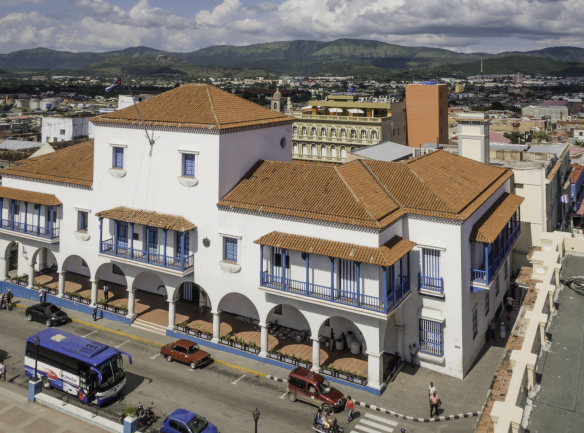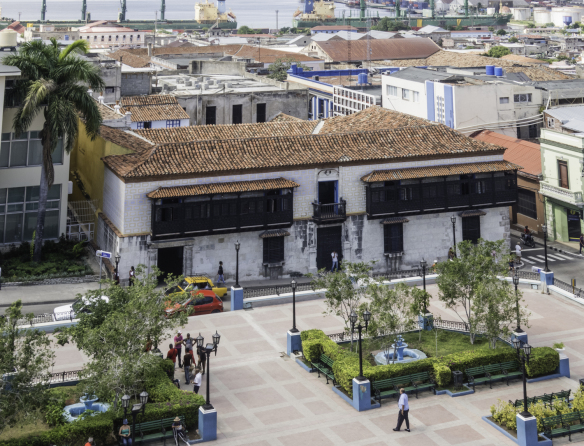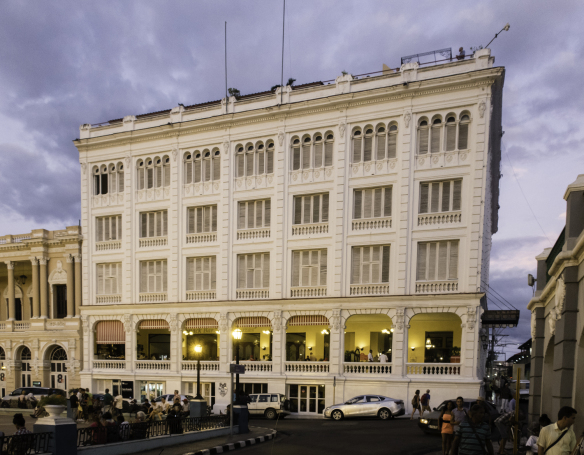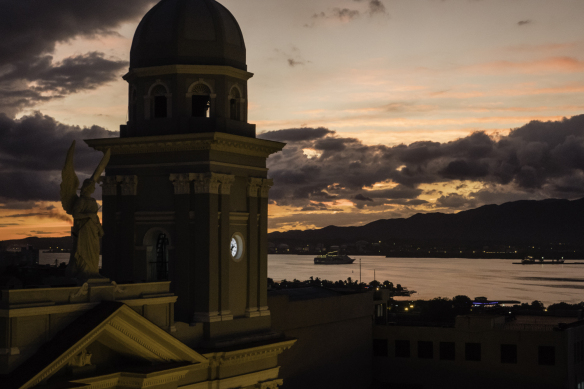Parque Céspedes, Santiago de Cuba, Cuba
 The epitome of romanticized Cuban street life, Parque Céspedes — surrounded by colonial architecture and the Cathedral — is a vibrant mix of conversation, flirting, dancing and music in the heart of Santiago de Cuba, Cuba
The epitome of romanticized Cuban street life, Parque Céspedes — surrounded by colonial architecture and the Cathedral — is a vibrant mix of conversation, flirting, dancing and music in the heart of Santiago de Cuba, Cuba
Located closer to Haiti and the Dominican Republic than Havana, Santiago de Cuba is called Cuba’s “Most Caribbean City.” It was founded as a Spanish settlement in 1515, and over the next several centuries, was invaded and conquered numerous times. Its rich history can be seen in the diverse backgrounds of its residents, whose Spanish, African, French, British, and Haitian roots are flavored in the city’s original and fascinating music, food, drink, and art. The second largest city in the country (after Havana), Santiago de Cuba is rich with history and pride. This history spans many centuries and includes the 19th century War of Independence, 1959 Revolution, and Bacardi’s first rum factory.
Often cited as the country’s cultural capital, Cuba’s second-largest city is also one of its oldest. A vibrant mélange of Afro-Caribbean culture, Santiago de Cuba is known as the birthplace of most of the country’s musical genres as well as Castro’s revolution. Our walking tour included the central Parque Céspedes, a lively gathering spot both day and night. The square is surrounded by a number of architectural landmarks that were fully restored for the city’s quincentennial in 2015. Highlights include the Catedral de Nuestra Señora de la Asunción with its magnificent painted ceiling, and the Museo de Arte Colonial, housed in the former home of Cuba’s first Spanish governor, Diego Velazquez de Cuéllar.
 Nuestra Señora de la Asunción Cathedral (The Basilica Cathedral of Our Lady of the Assumption) is located in the Parque Céspedes, Santiago de Cuba, Cuba
Nuestra Señora de la Asunción Cathedral (The Basilica Cathedral of Our Lady of the Assumption) is located in the Parque Céspedes, Santiago de Cuba, Cuba
The beautiful Nuestra Señora de la Asunción Cathedral (The Basilica Cathedral of Our Lady of the Assumption) is a national monument and a landmark within the city of Santiago. The present church was completed in 1922; however, there has been a cathedral on the site since 1522, shortly after the city’s founding. The crowning glories are the cathedral’s two Neoclassical towers, seen as beacons for the faithful.
 Dating from 1522, Museo de Ambiente Histórico Cubano (located in Casa de Don Diego Velázquez) is the oldest house still standing in Cuba
Dating from 1522, Museo de Ambiente Histórico Cubano (located in Casa de Don Diego Velázquez) is the oldest house still standing in Cuba
Dating from 1522, Museo de Ambiente Histórico Cubano (located in Casa de Don Diego Velázquez) is the oldest house still standing in Cuba. It was the official residence of the island’s first governor, Diego Velázquez. Restored in the late 1960s, this former trading house and gold foundry was inaugurated as a museum in 1970. Today, rooms hold period furnishings and decorations from the 16th to 19th centuries.
 Architectural detail on one of the colonial buildings around Parque Céspedes
Architectural detail on one of the colonial buildings around Parque Céspedes
 A contemporary building adjacent to Parque Céspedes that incorporates many updated colonial architectural design details
A contemporary building adjacent to Parque Céspedes that incorporates many updated colonial architectural design details
 The rooftop bar at Casa Granda Hotel (Hotel Casagranda) was a wonderful spot for a drink at sunset and dusk, overlooking Parque Céspedes and the adjacent Cathedral
The rooftop bar at Casa Granda Hotel (Hotel Casagranda) was a wonderful spot for a drink at sunset and dusk, overlooking Parque Céspedes and the adjacent Cathedral
 Nuestra Señora de la Asunción Cathedral (The Basilica Cathedral of Our Lady of the Assumption) at dusk
Nuestra Señora de la Asunción Cathedral (The Basilica Cathedral of Our Lady of the Assumption) at dusk
 A statue and one of the Cathedral’s two Neoclassical towers at dusk, overlooking Bahia de Santiago de Cuba
A statue and one of the Cathedral’s two Neoclassical towers at dusk, overlooking Bahia de Santiago de Cuba
Ready to learn more?
Determine whether life aboard The World is the right fit for you. Talk to one of our Residential Advisors today to learn more about this unique lifestyle, details of upcoming Journeys and Expeditions, and ownership opportunities.



